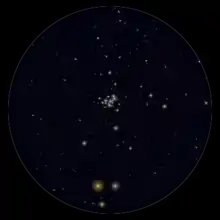HD 151932
HD 151932, also known as WR 78, is a Wolf-Rayet star located in the constellation Scorpius, close to the galactic plane. Its distance is around 1,300 parsecs (4,200 lightyears) away from the Earth.[10] Despite being a blue-colored Wolf-Rayet star, it is extremely reddened by interstellar extinction, so its apparent magnitude is brighter for longer-wavelength passbands.[4] HD 151932 lies about 22′ west of the open cluster NGC 6231, the center of the OB association Scorpius OB1; it is not clear whether it is a part of the association or not.[8] With an apparent magnitude of about 6.5,[4] it is one of the few Wolf-Rayet stars that can be seen with the naked eye (although it can only be seen with the naked eye under excellent viewing conditions).
 | |
| Observation data Epoch J2000 Equinox J2000 | |
|---|---|
| Constellation | Scorpius |
| Right ascension | 16h 52m 19.24769s[1] |
| Declination | −41° 51′ 16.2631″[1] |
| Apparent magnitude (V) | 6.45 - 6.61[2] |
| Characteristics | |
| Spectral type | WN7h[3] |
| U−B color index | -0.63[4] |
| B−V color index | +0.27[4] |
| Variable type | WR[2] |
| Astrometry | |
| Radial velocity (Rv) | −25.00[5] km/s |
| Proper motion (μ) | RA: −1.914±0.169[6] mas/yr Dec.: −2.402±0.097[6] mas/yr |
| Parallax (π) | 0.7679 ± 0.0649[6] mas |
| Distance | 1,250+150 −120[7] pc |
| Absolute magnitude (MV) | –5.83[3] |
| Details | |
| Mass | 22[3] M☉ |
| Radius | 10.14[3] R☉ |
| Luminosity (bolometric) | 630,000[3] L☉ |
| Surface gravity (log g) | 3.5[8] cgs |
| Temperature | 50,100[3] K |
| Other designations | |
| Database references | |
| SIMBAD | data |

Like most extremely massive stars, HD 151932 is losing mass via its stellar wind. The total rate of mass loss is 5×10−5 M☉/yr.[10] The multiplicity (i.e., whether the star is a single star or a binary star system) of HD 151932 has not been studied very much.[11] A periodic shift in the spectrum with a period of 3.3 days (implying it is a spectroscopic binary) has been noticed, but it may be spurious; the star appears to be a single star but may be orbiting face-on and/or with a lower-mass companion.[8]
The spectrum of HD 151932 is unusual: part of the He I absorption lines are known to be shifted towards the violet side of the electromagnetic spectrum – this has been interpreted as an expanding stellar shell.[8] Related to this is the fact that the Si IV line varies irregularly in radial velocity, the nature of which is largely unknown.[12] X-rays have been detected from this star, along with several other Wolf-Rayet stars such as WR 24 and WR 136.[10]
References
- van Leeuwen, F.; et al. (2007). "Validation of the new Hipparcos reduction". Astronomy and Astrophysics. 474 (2): 653–664. arXiv:0708.1752. Bibcode:2007A&A...474..653V. doi:10.1051/0004-6361:20078357. S2CID 18759600.
- Samus, N. N.; Durlevich, O. V.; et al. (2009). "VizieR Online Data Catalog: General Catalogue of Variable Stars (Samus+ 2007-2013)". VizieR On-line Data Catalog: B/GCVS. Originally Published in: 2009yCat....102025S. 1. Bibcode:2009yCat....102025S.
- Sota, A.; Maíz Apellániz, J.; Morrell, N. I.; Barbá, R. H.; Walborn, N. R.; Gamen, R. C.; Arias, J. I.; Alfaro, E. J.; Oskinova, L. M. (2019). "The Galactic WN stars revisited. Impact of Gaia distances on fundamental stellar parameters". Astronomy & Astrophysics. A57: 625. arXiv:1904.04687. doi:10.1051/0004-6361/201834850. S2CID 104292503.
- Heske, A.; Wendker, H. J. (1985). "Further photometry and spectroscopy in the young cluster region TR 24/Sco OB 1". Astronomy and Astrophysics. 151: 309–314. Bibcode:1985A&A...151..309H.
- Gontcharov, G. A. (2006). "Pulkovo Compilation of Radial Velocities for 35 495 Hipparcos stars in a common system". Astronomy Letters. 32 (11): 759–771. arXiv:1606.08053. Bibcode:2006AstL...32..759G. doi:10.1134/S1063773706110065. S2CID 119231169. Retrieved 12 December 2016.
- Brown, A. G. A.; et al. (Gaia collaboration) (August 2018). "Gaia Data Release 2: Summary of the contents and survey properties". Astronomy & Astrophysics. 616. A1. arXiv:1804.09365. Bibcode:2018A&A...616A...1G. doi:10.1051/0004-6361/201833051. Gaia DR2 record for this source at VizieR.
- Crowther, Paul A.; Rate, Gemma (2020). "Unlocking Galactic Wolf–Rayet stars with Gaia DR2 – I. Distances and absolute magnitudes". Monthly Notices of the Royal Astronomical Society. 493 (1): 1512–1529. arXiv:1912.10125. Bibcode:2020MNRAS.493.1512R. doi:10.1093/mnras/stz3614. S2CID 209444955.
- Seggewiss, W.; Moffat, A. F. (1979). "The intrinsically bright Wolf-Rayet stars of type WN 7. III - The probable single SCO OB 1 star HD 151932 with variable He I envelope". Astronomy and Astrophysics. 72 (3): 332–338. Bibcode:1979A&A....72..332S.
- "HD 151932". SIMBAD. Centre de données astronomiques de Strasbourg. Retrieved 18 February 2017.
- Skinner, S. L.; Zhekov, S. A.; Güdel, M.; Schmutz, W.; Sokal, Kimberly R. (2010). "X-ray Emission from Nitrogen-Type Wolf-Rayet Stars". The Astronomical Journal. 139 (3): 825–838. arXiv:0912.1326. Bibcode:2010AJ....139..825S. doi:10.1088/0004-6256/139/3/825. S2CID 119184875.
- De Becker, M.; Raucq, F. (2013). "Catalogue of particle-accelerating colliding-wind binaries". Astronomy & Astrophysics. 558: A28. arXiv:1308.3149. Bibcode:2013A&A...558A..28D. doi:10.1051/0004-6361/201322074. S2CID 53367145.
- Vreux, J. M.; Manfroid, J.; Scuflaire, R.; Magain, P. (1987). "HD 151932 variability revisited". Astronomy and Astrophysics. 180: L17–L19. Bibcode:1987A&A...180L..17V.